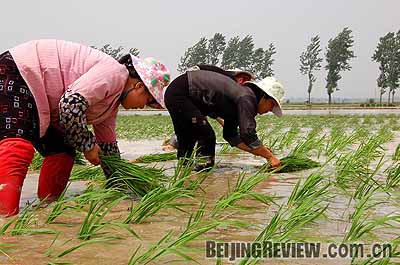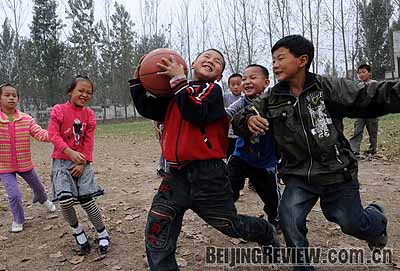| The traditional division of labor in rural China is that men work in the fields, while women do housework. Yet, Wu Huifang, a researcher with the College of Humanities and Development, China Agricultural University, has met many women who do both. These rural women, whose husbands are migrant workers in the city, are known as left-behind women.
 |
|
HARD LABOR: Left-behind women from Kongdian Town in Huainan City, Anhui Province, plant rice on June 6, 2008 |
 |
|
SECOND HOME: Kids in the playground of a special home for left-behind children, in Sanliqiao Primary School, Luohe City, in Henan Province (CHEN BIN) | One of the women Wu met in Sichuan Province during a site study was a 43-year-old who has been married for 20 years. Ever since their marriage her husband has spent a good part of each year working on a construction site in the city. In addition to taking care of their child and parents, the woman manages two large mushroom greenhouses, feeds silkworms and grows rapeseed and rice on two patches of land.
Wu recently published her site visit findings in a book titled Dancing Solo: Women Left Behind in Rural China, co-authored with Ye Jingzhong, a professor at China Agricultural University.
The book is one result of a research project on left-behind people in rural China, a project led by Ye. The research project was launched in 2004 and focused on left-behind children in central and western regions. Since November 2006, research team members, including Wu, whose focus is left-behind women, have visited hundreds of rural families in Anhui, Jiangxi, Hunan, Henan and Sichuan provinces. The study sheds lights on the life of three groups of people, that is, left-behind children, women and elderly. The condition of the left-behind children and elderly are portrayed respectively in two books titled Differentiated Childhoods and Lonely Sunset.
The research team sponsored a symposium in Beijing in December last year, and presented their research results. Scholars and representatives from government and non-governmental organizations attended the symposium. Among the scholars were representatives from education and research institutes, including Peking University, the Renmin University of China and the Henan Provincial Academy of Social Sciences.
Duan Chengrong, a professor in the Population and Development Research Center of the Renmin University of China, said he thought the book Differentiated Children a great work, for it unfolds a panorama of left-behind children in rural areas. Jiang Yongping, Director of the Policy and Law Research Office of the All-China Women's Federation, remarked that the study on left-behind women has filled several vacuums in this research area. Mu Guangzhong, a professor on population research in Peking University, praised the study on left-behind elders as pioneering.
Vulnerable groups
Migrant rural workers have played an important role in urban development since the 1980s. Their social condition has been widely discussed, while their family members left behind have received little attention until recently. According to a research center on the left-behind population in the School of Public Policy and Management in China Agricultural University, as of 2007, the number of left-behind children, women and elderly was 23 million, 47 million and 18 million, respectively.
While migrant rural workers face challenges to make a living in cities, their families back home are faced with many social and psychological issues.
The book Dancing Solo by Ye and Wu identified some major problems that left-behind women encounter. Among the hundreds of women that the researchers interviewed, the husbands of a little over two thirds are not at home for three to four quarters of each year. A little over half of these husbands have been living primarily in cities for over 10 years, and nearly half of them visit home once a year.
|
